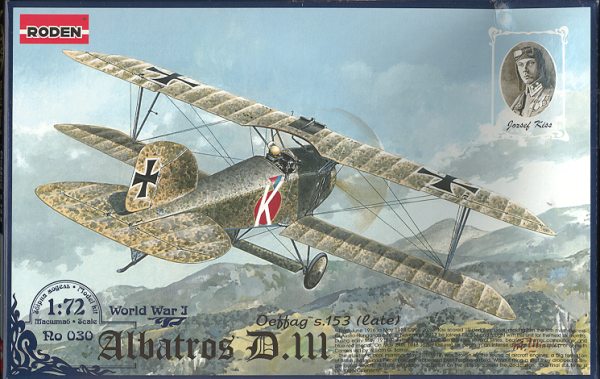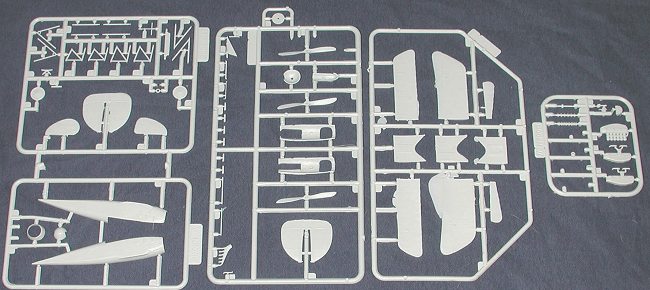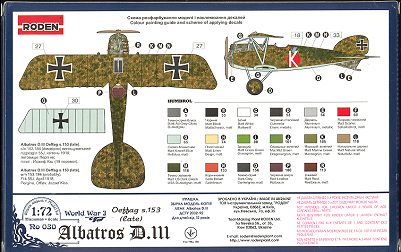
|
KIT: |
Roden 1/72 Oeffag S.153 (late) Albatross D.III |
|
KIT # |
030 |
|
PRICE: |
$9.98 ($8.96 at Squadron) |
|
DECALS: |
12 aircraft (!) |
|
REVIEWER: |
|
|
NOTES: |

|
HISTORY |
As with many aircraft over time, successful (and sometimes those that don't quite meet that appellation) aircraft are often built under license. It is the same with a lot of things from cars to Coca-Cola. The Albatros D.III was a rather successful aircraft and so it wasn't unusual that it would be built by one of Germany's partners in WWI, the Austro-Hungarian Empire.
Built in Austria by the Oeffag company, it underwent several unique modifications that were not done to the original German Design. This particular aircraft was the series 153 (s.153) version of the aircraft and differed in having a 200 hp engine in place of the original 185 hp version. The wings and airframe were basically unchanged. An order for 111 aircraft was increased to 281. Though there was little difference between the 153 series aircraft and the earlier version, a series of mishaps with the spinner flying off caused a design change in the nose of the plane after the 112th aircraft. This actually increased speed by 15 kph!
It was a well liked aircraft and flown with zest by Austrian pilots. The war in this part of the world was not as intense as it was on the Western front so a huge number of aircraft were not really needed. The main opponent was Italy, itself without a really large air force. Production ended in June 1918, with the newer series 253 aircraft leaving the production lines. Even after the end of the war, a large number of 153 series aircraft were used by other countries in the area such as Poland, Czechoslovakia and Ukraine.
|
THE KIT |

Roden has an excellent reputation for producing quality WWI kits. This one follows some of those. Molded (or at least boxed) in Ukraine, the quality of the moldings is really very good. There are no problems with ejector pin marks; careful inspection finding them only on the inside of large parts like the fuselage halves. There were no sink marks, but this particular kit had quite a bit of flash on some of the parts as you can see on the large right-hand sprue. Other parts had some rough edges, but nothing major.
The sprue attachment points are commendably small. Some of the parts are very fragile looking and it would behoove the careful builder to use a razor saw to remove some of these parts to prevent breakage. As you can see from the sprues, there are lots of additional parts. This same sprue set is used for a number of different variants; the instructions being clear as to which parts are not to be used and consigned to the spares box.
 The instructions are superb.
There are several easy to follow construction steps that annotate colors and
which options are used with which decal selection. It seems that colors are all
in the Humbrol range, which is most widely used in Europe so a natural to use.
The decal sheet for this particular kit is quite impressive, giving a total of
12 different options! The decals are quite well printed with no obvious
registration errors. They are also semi-matte and appear quite thin, so should
fit well. You'll excuse me if I don't cover the options all as there really are
too
The instructions are superb.
There are several easy to follow construction steps that annotate colors and
which options are used with which decal selection. It seems that colors are all
in the Humbrol range, which is most widely used in Europe so a natural to use.
The decal sheet for this particular kit is quite impressive, giving a total of
12 different options! The decals are quite well printed with no obvious
registration errors. They are also semi-matte and appear quite thin, so should
fit well. You'll excuse me if I don't cover the options all as there really are
too  many, however there are a
wide range of camouflage schemes. One is for the box art plane of ace Josef
Kiss. The back of the box has a full color two view of his aircraft as well as a
color chart for all the colors used in making the kit. A very nice touch that I
hope will catch on. Each of the 12 schemes gives information on the pilot who
flew the plane. A good reference would be
'Air Aces of the Austro-Hungarian Empire; 1914-1918'. I imagine that the
researchers used this tome to gather markings info. Good luck for those who will try to replicate some of these
fabric schemes as some of them are quite complex and convoluted! Now if we can
get these guys to use real boxes instead of these 'open and both end' ones, but
I'm not holding my breath.
many, however there are a
wide range of camouflage schemes. One is for the box art plane of ace Josef
Kiss. The back of the box has a full color two view of his aircraft as well as a
color chart for all the colors used in making the kit. A very nice touch that I
hope will catch on. Each of the 12 schemes gives information on the pilot who
flew the plane. A good reference would be
'Air Aces of the Austro-Hungarian Empire; 1914-1918'. I imagine that the
researchers used this tome to gather markings info. Good luck for those who will try to replicate some of these
fabric schemes as some of them are quite complex and convoluted! Now if we can
get these guys to use real boxes instead of these 'open and both end' ones, but
I'm not holding my breath.
|
CONCLUSIONS |
In all respects, this looks like a very nice kit. The minor problem with flash can easily be taken care of and is not endemic to the mold. Another Albatros kit I have was devoid of the large areas of flash seen in the image above. Because of the small and delicate parts, I wouldn't recommend this to a beginner, but if WWI aircraft are your forte, then this one should be on your want list!
You can find this kit and many others at

If you would like your product reviewed fairly and fairly quickly by a site that has well over 150,000 visitors a month, please contact me or see other details in the Note to Contributors.